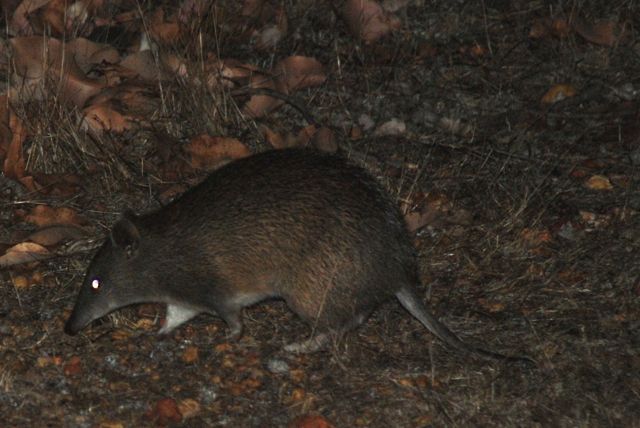Karakamia…. 275 hectares owned and managed by the conservation NGO the Australian Wildlife Conservancy. One hour’s drive east of Perth in the Darling Ranges. In Nyoongah, the original language around here: Karak: cockatoo. Mia: home.
Last night I was there.
After arriving we passed through an electronic gate, and past the electrified wire fence that extended for 9kms around the edge of the property. As we drove through Karakamia towards the little hut that is the visitor’s centre I saw elder marri trees standly with an aged dignity uncommon in much of the Perth hills. Not only that but there were huge trunks strewn about the earth here and there, left to decay and some of them suitably inhabited, no doubt, by furry little animals.
After a preliminary talk about the history of Karakamia I and my group of friends began our two hour guided walk through the property. The moon was full and shone down through a gauze of cloud. The air was warm and slightly humid.
It has been a long, dry summer, and the understorey was full of old leaves that crackled in the still night as you walked over them. Making our way along the darkened path down a west-facing slope we heard a rustle in the dry leaves to our right. Lisa, our guide, swung her spot-light in the direction of the noise and highlighted a furtive quenda, otherwise known as a southern-brown bandicoot. The quenda doesn’t hop like the macropods, it does an ungainly trot through the undergrowth on all fours. Its coat was sleek and shined in the torchlight, a sign of its good health. Its brown nose was long, almost like an ant-eater, and pointed down to the soil where it foraged for insects in. Its little black snout was wet and shined in the light.
We left the quenda to the peace of a summer’s night and continued on down the track. The torch beam caught the silvery tracery of a spider web. The torch sought its quarry and a frighteningly large Golden Orb Weaver was in the limelight. The spider waved its arms in protest at the intruders.
Onwards. Crackle, crackle, crackle. Then Maria said stop, and pointed forward at the ground. The light was shone, and at our feet stood the tiny figure of a woylie, or burrowing betong. It looked up at us for a few moments, a fraction of our size and unsure of what was going on as it stood under this sudden downpour of intense light. Then it bounced off into the jarrah understorey. Bounced rather than bounded I should add. As I’ll explain this later.

Walking through the bush on this balmy summer night I could almost feel myself walking through a historical drama. I was appropriately attired for a colonial costume drama from the 1890s and after a dinner party late one night we’d decided to take a stroll out through the little known Australian bush under the full moon. We had wandered down a cart-track under the full moon, through the jarrah trees and the banksias. The place still echoed with the spirits of its Aboriginal companions. The marsupials of the forest were still healthy and ever present. If disturbed one bounced away or wandered off through the shrubs. The place was still wild. You could feel the pressure of wildness. Back in 2009 reality, the spirits of the bush are still in residence.
The walk finished and we retired for a drink at the visitor’s centre. As we were about to leave Karakamia, about ten o’clock, I made my way to the small gravel car park by myself. A small brown shape appeared before me on the edge of the gravelled area. I stopped. It was a woylie. I sat down on the ground. The sound of the others from the verandah of the visitor’s centre came to me in snatches of laughter and talk, but I was mostly enveloped in the calm of the warm night in the forest. The towering shapes of old marri trees in a long-disused field spread out to my west. The little woylie eventually became used to my shape and started, slowly, towards me.
How can I describe its movements? It hopped forward in diminutive, elegant bobs. As it hopped forward and moved past me to my right, incredibly close, I was entranced by the way in which its head pointed forward and down and it made its rapid jumps with a mixture of flowing confidence and touching smallness of motion. I’m used to seeing Western Grey kangaroo’s bound, and compared to that easy, long roll, the gait of the woylie is entirely different. It is like seeing a cougar run across a field in the mountains of California, and then later watching a chipmunk scramble along a rocky path. And in fact that was the next thought that came into my mind: I’ve seen many squirrels and chipmunks in America, but not once while growing up in Australia did a woylie bounce past my family’s tent.
As beautiful as the little fellow was, something is wrong in this scene. Here I was, thirty years old, sitting on the gravel in the carpark of Karakamia and seeing for the first time in my life the animal that should be so common to my forests and fields, the beautiful little creature that should be such a recognizable feature of the place I come from. I have spend quite a bit of time in the natural environment in Australia, and I have never before seen a woylie.
To the WA government: Do whatever it takes to bring back our animals. Don’t leave it to the efforts of private philanthropy. Make the bush live.
